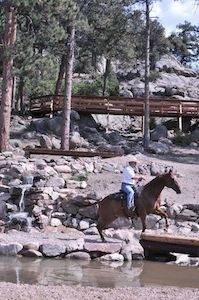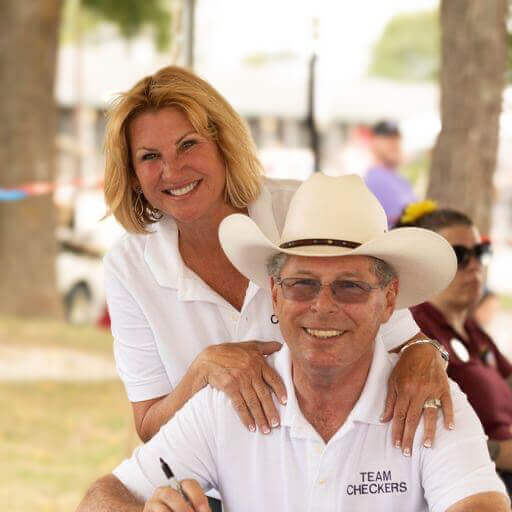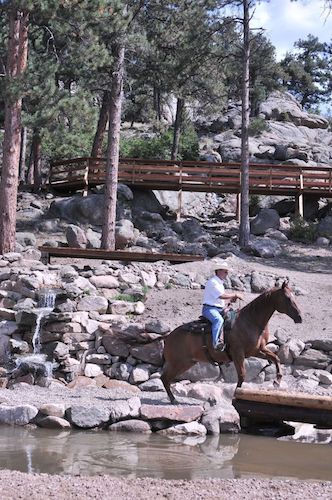Patience and Time Leads to Success
by Mark Bolender

In any equine discipline, a consistent cadence with forward motion is a desired skill. This skill does not come easily but is worth the work that goes into it. In the discipline of Mountain Trail this is a skill that will be needed. Even though Mountain Trail is a forward equine discipline where covering ground is a desired trait, speed control and maintenance is a must. Depending on the pattern in a challenge/show, at level two or three you may need to be able to exhibit a number of gaits and different speeds within each gait. If you don’t have this skill, you must get help from a professional trainer, as it will be needed if you want to be safe and advance your horsemanship skills.
While judging IMTCA shows in Australia and Italy and watching competitors at a schooling show here at Bolender Horse Park, I noticed most riders struggled to maintain a consistent cadence over the double mini mounds, Bolender Peak, and a small hill in Italy. The “double mounds” are 4 feet high by 8 feet wide, and 48 feet apart. The slope is gentle with the slope meeting in the middle. Bolender Peak is tough; it rises 15 feet over just 36 feet of distance, and then turns at the top and drops off at the same slope. At the peak the gravel path has a good grip and is safe, but it is hard to maintain the same speed at any gait. Control and collection is a must to ensure safety while navigating the peak.
Going up the peak, the horses would speed up or break into a canterlope (since Mountain Trail combines English and Western, we have a canterlope rather than canter or lope). When they reached the top, horses would break into the correct gait of the trot/gait, speed up and slow down going up the second small mound, then speed up right before the water entry.
After each show I asked some riders why they had difficulty maintaining a consistent gait or speed over these obstacles. The answers were the same—very few had ever been confronted with anything other than a flat surface and had no idea how to maintain the requested speed. They were fascinated by how difficult a skill it was.
Here is how I teach it. First, I start with the walk and teach them to walk slow, medium and fast. I start in the arena and when the horse changes speeds, I simply turn into the wall and change directions until the horse listens to me and maintains the requested speed.
After mastering the skill in the arena, I head to the outdoor trail course. I start with just the flat walk in and out of obstacles and water crossings. Next, I address the mounds and hills. When going up or down the undulating terrain, I stop the horse and back it up if I have a change of speed. Going uphill, I use a soft leg and a soft feel of the horse’s mouth while I lean slightly forward. Going down, I do the same but sit slightly back. Each time I try to make my cues less and try for less and less contact with the horse’s mouth.
When I’m able to maintain the requested pace, I move to the trot or gait. The process is the same as teaching the horse to walk but will take considerably more time to master. Any time an increase of speed is added, the new skill will take more time. Take time each day for several weeks to trot/gait on the flat and then over the hills and mounds.
Once the trot/gait is mastered, I move onto the canterlope. As in the walk and trot/gait, everything is the same for training for the consistent canterlope. This skill will take several months to master on a loose rein.
Two common mistakes in training for consistent speed or cadence are 1) trying to push too hard and fast and 2) letting emotions into the equation.
With patience, you’ll develop the ability to maintain a consistent speed in the requested gait and avoid losing a point for each change of speed under IMTCA judging rules. To be competitive, each point counts; plus, a consistent speed is just pleasant to ride.
Happy Trails and Bolender Blessings.
Originally Published June 2017 Issue

Mark and Lee Bolender own and operate Bolender Horse Park in Washington State, which houses the finest Mountain Trail course in the world. They are the founders of the International Mountain Trail Challenge Association (IMTCA) and travel worldwide as clinicians and ambassadors of Mountain Trail. Bolender Horse Park offers riders of all skill levels and disciplines a fun and challenging trail riding adventure.
Mark has designed and built Mountain Trail courses in the USA, Canada, Australia, and Europe—with many more in development. Mark uses his artistic, landscaping, horse training, and construction skills to build these courses (NW Steel Design LLC www.nwsteeldesign.com).
Mark is the author of Bolender’s Guide to Mastering Mountain and Extreme Trail Riding. Visit www.bolenderhorsepark.com to learn more.






